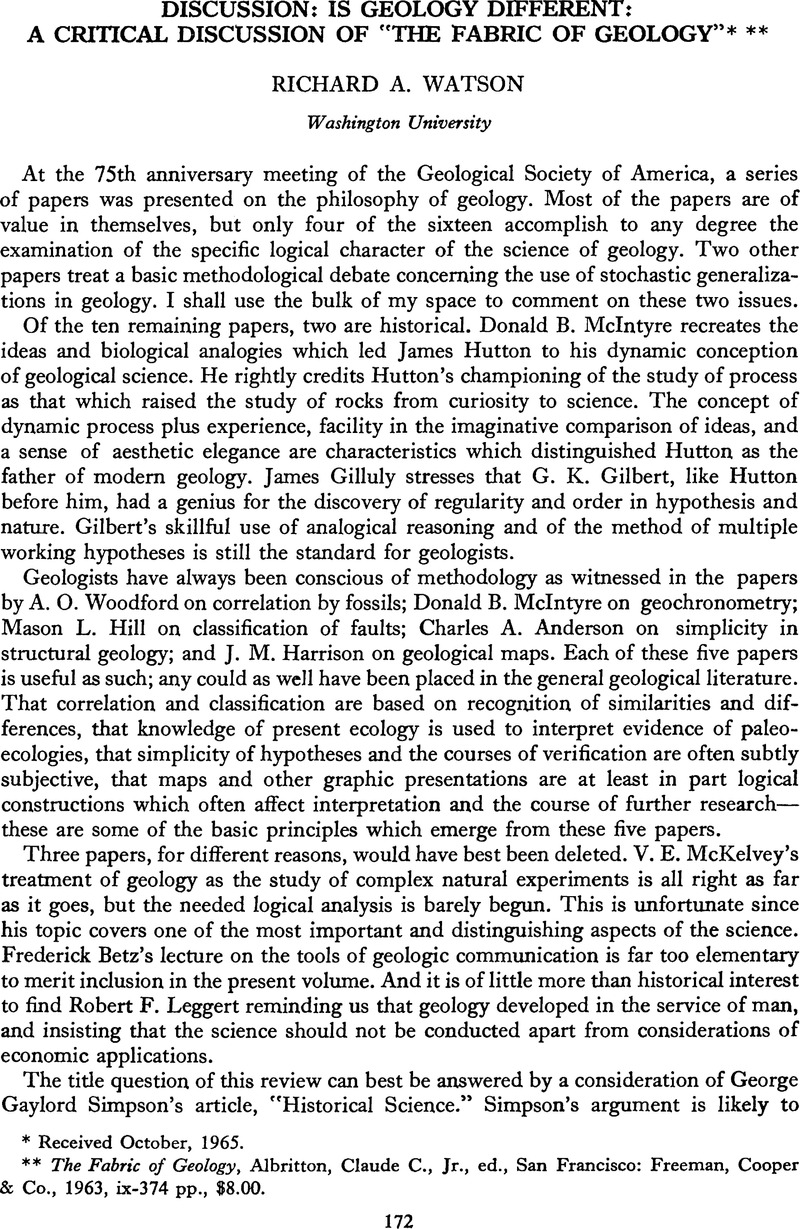Article contents
Discussion: Is Geology Different: A Critical Discussion of “The Fabric of Geology”
Published online by Cambridge University Press: 14 March 2022
Abstract

- Type
- Discussion
- Information
- Copyright
- Copyright © 1966 by The Philosophy of Science Association
Footnotes
The Fabric of Geology, Albritton, Claude C., Jr., ed., San Francisco: Freeman, Cooper & Co., 1963, ix-374 pp., $8.00.
References
1 Simpson points out that in traditional terms there are “historical” and “nonhistorical” parts of all sciences, including chemistry and geology. I shall follow his practice of noting this, but using chemistry as an example of a nonhistorical science, and geology as an example of an historical science.
2 I contend that the two terms are misleading, marking no logical difference, but at most a difference between the difficulty of different branches of science, or the different interests men have concerning different subject matters.
3 Bieri, Robert. “Huminoids on other Planets ?”, American Scientist, LII, 1964, pp. 452-458. See also: Hoyle, Fred. Of Men and Galaxies, Seattle: University of Washington Press, 1964, vii-73 pp.
4 Scriven, Michael. “Explanation and Prediction in Evolutionary Theory. Satisfactory explanation of the past is possible even when prediction of the future is impossible.” Science, CXXX, No. 3374, 28 August 1959, pp. 477-482. See also: Simpson, George Gaylord. “Biology and the Nature of Science,” Science, CXXXIX, No. 3550, 11 January 1963, pp. 81-88.
5 For an explicit statement of this method, see: Watson, Richard A. “Similitude in Direct and Thought Experiments in Cave Geology,” Bulletin of the National speleological Society, XXVII, 1965, pp. 65-76. Hume's comments on the science of moral philosophy in which for different reasons actual experiments cannot be performed are pertinent here. Hume says, “We must therefore glean up our experiments in this science from a cautious observation... and take them as they appear in the common course of the world... Where experiments of this kind are judiciously collected and compared, we may hope to establish on them a science, which will not be inferior in certainty... to any other of human comprehension.” Hume, David. A Treatise of Human Nature, edited by L. A. Selby-Bigge, Oxford: Oxford University Press, 1955, p. xxiii.
6 See reference to Scriven in footnote 4. Also: Scriven, Michael. “Explanations, Predictions, and Laws,” Scientific Explanation, Space, and Time, Minnesota Studies in the Philosophy of Science, III, edited by Herbert Feigl and Grover Maxwell, Minneapolis: University of Minnesota Press, 1962, pp. 170-230.
Hempel, Carl G. Aspects of Scientific Explanation, and other Essays in the Philosophy of Science, New York: The Free Press, 1965, ix-505 pp.
7 Geological Survey Professional Paper 500-A, 1962, pp. A1-A20. See also: Hack, John T. “Interpretation of Erosional Topography in Humid Temperate Regions,” American Journal of Science, Bradley Volume, Vol. 258-A, 1960, pp. 80-97.
8 Albritton has prepared a second, and is preparing a third bibliography. See: Albritton, Claude C., Jr. “Second Bibliography and Index for the Philosophy of Geology,” Journal of the Graduate Research Center, XXXIII, Southern Methodist University, 1964, pp. 73-114.
- 16
- Cited by




